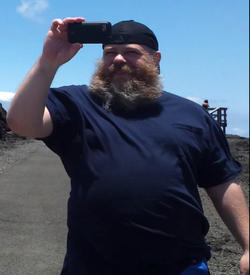what does skinny fat look like?
Replies
-
This is me. This is what skinny fat looks like & I hate it! Trying to get rid of it. I am probably the textbook definition.
You look great.
You aren't skinny fat. Looking at your picture, I'd guess about 25% bf (dangerous to guess)
Skinny fat is 35%bf or higher for someone with a BMI in the "normal" range.
Good luck onyour goals! Please understand that your body is normal and fine - you can go for more fit look, if that is what you want. But let go the hate.Yes, this. Don't mistake "I'm not at my goal yet" for something "there's something wrong with me."
Yes, I've been guessed to b 25% But I'm 5'4 3/4 119lb. That is a bit too high of a BF% for my height & weight I would think. In a few more lbs I'll almost be underweight I hope by that point I can be 20% so I can bulk, but idk if it will happen. Once I posted with my pictures on here & people called me the definition of skinny fat. 0
I hope by that point I can be 20% so I can bulk, but idk if it will happen. Once I posted with my pictures on here & people called me the definition of skinny fat. 0 -
Here some tips to become skinny-fat:
1. Eat a Vegan Diet – If you don’t want to eat any meat, your body will just eat you instead. Unfortunately it’s on a low fat diet in this case.
2. Do lots of cardio – Training your body to be catabolic, breaking down muscle and to store fat is great if you want that “I used to be 300 lbs until I got sick” look.
3. Take lots of thermogenic fat burners – Nothing like turning up the furnace while the windows are open. The room might get warmer, but the bill in the end is never pleasant. Thermogenic maybe be short term fat burners, but in the long run they are more muscle burners and long term fat storers.
4. Go on a low calorie starvation diet – The HCG diet is a great examples. It’s like paying for the experience of a prison camp without making any new undesirable friends.
5. Join weight watchers – Obviously the only point these people haven’t gotten is that if you want to be healthy you should eat a healthy diet and exercise. Is there an app for that?
6. Take a spin class – Did you know spinning classes actually increase lower body fat. Do enough of them and you might slim your waist after you have completely fried your adrenals, but by then you will be sports some major cottage cheese thighs.
7. Never pick up a weight ever – I’m serious, it will make you so huge you will have to walk sideways down the hall to your office. Ok not really, but you know that age old testament, if you don’t use it you lose it. Well it’s pretty accurate when it comes to muscle tissue. If you don’t want to be Skeletor for next Halloween, then you might start moving some iron.
8. Skip meals – Skipping meals is like training for fat storage. The more you go without proper nutrition the more you tell you body to store fat for these long breaks.
9. Eat lots of Gluten – Nothing says lose muscle and store fat like a highly inflammatory food that depletes your body of vital nutrients and damages your digestive tract making it harder for you to get nutrients from the rest of your diet.
Head scratch....
Anyways I could not show you the definition because it would violate HIPAA, but it looks like elevated triglycerides, LDL, and cholesterol. Poor HDL. Osteopenia with the begining of osteoporosis. Hypertension. Short of breath. In general, a thin person in poor health.0 -
This is me. This is what skinny fat looks like & I hate it! Trying to get rid of it. I am probably the textbook definition.
You look great.
You aren't skinny fat. Looking at your picture, I'd guess about 25% bf (dangerous to guess)
Skinny fat is 35%bf or higher for someone with a BMI in the "normal" range.
Good luck onyour goals! Please understand that your body is normal and fine - you can go for more fit look, if that is what you want. But let go the hate.Yes, this. Don't mistake "I'm not at my goal yet" for something "there's something wrong with me."
Yes, I've been guessed to b 25% But I'm 5'4 3/4 119lb. That is a bit too high of a BF% for my height & weight I would think. In a few more lbs I'll almost be underweight I hope by that point I can be 20% so I can bulk, but idk if it will happen. Once I posted with my pictures on here & people called me the definition of skinny fat.
I hope by that point I can be 20% so I can bulk, but idk if it will happen. Once I posted with my pictures on here & people called me the definition of skinny fat.
If you got a cent for every stupid thing posted here you'd be richer than Cresus.
25% is normal. As we grow older we have a tendancy to gain bf at ANY weight.
Work out hard, you'll get what you want - but really, you look good. Having an attitude of "am good want more" will help you get to your goal.0 -
This was a disturbing read for me. I went to the Dr after hot flushing every time I ate 1000kcal +, having just found out two relatives were pre-diabetic, and she just laughed and said I was too thin. My bloods were fine, but so were my relatives'... It was the glucose test that showed up the problem for them.0 -
I am fat fat so I guess I am triple the "eeww" If that is what skinny fat is, sign me up! I strive to be as yucky as you are.
Word.0 -
Here some tips to become skinny-fat:
2. Do lots of cardio – Training your body to be catabolic, breaking down muscle and to store fat is great if you want that “I used to be 300 lbs until I got sick” look.
6. Take a spin class – Did you know spinning classes actually increase lower body fat. Do enough of them and you might slim your waist after you have completely fried your adrenals, but by then you will be sports some major cottage cheese thighs.
I think these points were a bit much.
Agreed... I do a lot of cardio, including spinning, and I'm hardly "skinny fat".
(BTW, that first photo is of Karolina Kurkova, one of THE most famous Victorias Secret models. That photo was actually photoshopped to give her a bit of extra fat... she doesn't look like that at all. It's a fake photo. I understand it is for example purposes but it's not real.)
Regardless, "skinny fat" is a relative term. What one person considers SF another may not. Its like asking, "what does a fat person look like? What does a skinny person look like?" It is going to depend on the person answering the question.
Medical terms of "Obese" and "Normal weight obesity" are much less subjective however. They are based on body fat percentages and are actual medical diagnosis, not just someone's personal opinion. I think that more people should be aware of Normal Weight Obesity, as it is an actual medical condition and carries risks of heart disease and diabetes just like Obesity does (as well as other ailments) but does not garner the same attention. If the term "skinny fat", disgusting as it is, helps to get that information out there and draw attention to NWO perhaps its a good thing.
Like others have said, normal weight obesity is a medical term, a diagnosis that would be made by a professional after blood tests and medical examination. 'Skinny- fat' is a colloquial term that perhaps originally derived from the medical term of Normal Weight Obesity, but is now being used for body-shaming, and is directed at anyone, mostly women, who do not lift heavy, or those who eat at a lower calorie amount, and like to do cardio for exercise.
No one on this site has the credentials or ability to diagnose anyone else on here as being 'skinny-fat' based solely upon the way they look, or their choice of exercise method.
Mental retardation is a medical term used by professionals, however, the term 'retarded' has become a very offensive term that is no longer acceptable, as it is used as an insult and is very offensive to those with disabilities.
I would hope that the un-official term of 'skinny-fat', would become no longer acceptable for use on this site as well. But as long as body-shaming still exists, I imagine this term will continue to be used. And young women will continue to feel shame every time they see it described on here and they look in the mirror to see they are less than perfect.
Yes, it is grossly misused on this site every day, and is used as an insult.
I actually haven't seen that either. I don't think the term skinny-fat is offensive. If someone appears thin but their body fat % is in the overweight to obese range, they are fat. Body fat percentage is a much better indicator than BMI and no one is shaming anyone. You are entirely too sensitive.
I have never been accused of being too sensitive by anyone, other than my older sister who is a blatant 'witch' who covers up her low self-esteem by insulting everyone in her path, then if they call her out on it, she says they are 'too sensitive'. But that is just my issue with her.
I am secure enough at 49, that I am not going to have my self-worth affected by anything a stranger on an internet forum throws at me. However, there are many young girls on here that are still struggling with body image and self-worth, and when they see pics posted on here and people responding how horrible the girl's body looks, and they look in the mirror and see the same thing, it can be quite damaging.
If you honestly have not seen anyone on here use skinny fat as an insult, go read some of the 1200 calorie threads. That term gets thrown around a lot in those.
Some people may not have a problem with it, and may even use it to describe themselves, but that doesn't take away the fact that it is often misused, and is used as an insult towards certain body types.
One poster above described it as someone who has skinny arms and legs and a lot of fat in the midsection. Are you not aware that this is a genetic body shape? It is called an apple shape. Apples carry their extra fat in their midsection, whereas Pears carry their extra fat in their hips and thighs.
They both can lose body fat all over, but the last place it will leave is where they predominately carry that BF. That is the hardest fat to lose. You cannot spot reduce fat, so it doesn't matter what type of exercise you do, only an overall calorie deficit will get rid of that fat.
Yes, building muscle will help raise your BMR so that you burn more fat, but you can't determine where they fat will come from.
I am an apple shape. Even at my thinnest, I have always had extra fat around my waist. Even 20 yrs ago, when I was training with pro body builders and had some amazingly strong, well-defined muscles, and not an ounce of fat anywhere else, I still had fat in my midsection. There is only one inch between the bottom rib and my hip bone. Doesn't leave much room for the 'hourglass' shape. lol.
I was not 'skinny-fat' then, and now, 40 pounds heavier, I am not 'skinny-fat' either. Now I am just fat, but getting leaner.
I just wish we could get away from the skinny and fat labels and concentrate more on Healthy or Unhealthy.
ETA, and yes, I do see the irony in my last 2 statements :bigsmile:
I seriously think you're reading insults in to factual statements. High visceral fat is not an insult, it's a dangerous medical condition. A person can be a healthy weight, but if they have high visceral fat they're at equal risk for obesity-related diseases- including hypertension, diabetes, stroke, high cholesterol, cancers, etc- as any other obese person. In fact, their risk might be higher, because they're less likely to be aware of the risks and adjust their lifestyles accordingly.
As far as apple vs. pear shapes- yes, it is a body type. Unfortunately, it's much riskier to have an apple body-type than a pear type. Two women, otherwise equal- at the same body weight and same BF%, if one is a pear and one is an apple, the pear has much lower disease risk factors. It's not 'shaming' to be aware of clinical risk factors. One of the reasons that waist-to-hip ratio is currently being favored as a better risk factor predictor is that carrying midsection weight is dangerous. Unfortunately it does mean that apple shaped people may have to work harder and maintain a lower body fat percentage to be equally healthy as their pear-shaped counterparts.It sucks, but it's reality.
Bean, are you really saying you haven't seen skinny-fat used derogatorally on mfp? Most people using it on mfp are not talking about Normal Weight Obesity at all, just a little unwanted fat that hadn't gone at the weight they hoped it would. I agree that normal weight obesity requires more publicity, but 'skinny-fat' is not doing that. It has become a completely different beast and women are using it to beat themselves and others up with.
Genetically, being towards the top end of normal is not good for me: the double chin and the waist two sizes larger than my hips are a bit of a giveaway. Towards the bottom end of healthy (BMI of 20-22) these signs of excess fat pretty much disappear. Personally, I see this as just another weakness in the way people use BMI. My best weight is within the normal range (without adding much muscle) but that doesn't mean all weights within the normal range are healthy for me.0 -
Sigh.
I was skinny fat before I started this 4 months ago.
5ft 3, 137lbs and a BMI of 24.3. <---- within 'healthy normal range' for a woman.
BF% using various calculators, scales, etc: 33% <
Eeek!
When I started on MFP I hid my calorie counting and exercising from my friends and family (except for my husband). When I started running/exercising or refusing cake/chocolates many people said 'hey what are you doing that for, you are already skinny enough, not like me who is trying to lose x pounds!' This is very frustrating for a 'skinny fat' person. I literally could not walk briskly for 400 metres without huffing and puffing, and forget about running for the bus. Why is my goal of getting fit and healthy not as worthwhile as yours? Why am I not deserving of your support?
I started working out (often at home) and calorie counting but very quickly (within a couple of weeks) realised that 1.) I was starving myself and getting weaker and 2.) the weight was dropping off amazingly quickly but I wouldn't be happy with the end result. Did some reading on here, upped my calories and increased strength exercises and decreased cardio. Fiddled with macros to maximise protein.
Now:
5ft 3 (yep, haven't grown or shrunk), 122lbs and a BMI of 21.1 <--- still in the same 'normal healthy range'
BF % using the same various calculators, scales etc: 24% <---- much better
I don't have photos of before (only one that was snapped without me knowing). It is something that I quite regret now. I forbade anyone to take photos of me and refused to wear a bikini, disabled friends tagging me in photos on FB. There are virtually no photos of me that show more than my face for the last 7 years or so.
Now my goal is to lower that BF% instead of the weight. I have a way to go and I haven't really made much progress in the past month, but I realise that it will be slower the closer I get to my goal.0 -
This is me. This is what skinny fat looks like & I hate it! Trying to get rid of it. I am probably the textbook definition.
You look great.
You aren't skinny fat. Looking at your picture, I'd guess about 25% bf (dangerous to guess)
Skinny fat is 35%bf or higher for someone with a BMI in the "normal" range.
Good luck onyour goals! Please understand that your body is normal and fine - you can go for more fit look, if that is what you want. But let go the hate.
Yes, this. Don't mistake "I'm not at my goal yet" for something "there's something wrong with me."
QFT!
Repeat, over and over. "I'm not at my goal yet" does NOT mean "there's something wrong with me." It's ok to be a work in progress. Even fitness models have times of higher and lower bodyfat. That doesn't make them failures when they're on the higher end. It makes them human.0 -
Nnnnnnnooooooooooooooo don't do what I did. I waited until I was 5'7 and 120lbs before I started 'bulking' and as you can see on page 5 in the pictures on the left I had like no muscle so I had to gain 10lbs in hope of acquiring some muscle mass back and so I'm packing on the fat again. Back up to about 20%BF now. Some day, I well have that line down my stomach...it was the vaguest thing ever and I was about 17% BF. Retain the muscle you have now *creepy voice while rattling weights* train now.This is me. This is what skinny fat looks like & I hate it! Trying to get rid of it. I am probably the textbook definition.
You look great.
You aren't skinny fat. Looking at your picture, I'd guess about 25% bf (dangerous to guess)
Skinny fat is 35%bf or higher for someone with a BMI in the "normal" range.
Good luck onyour goals! Please understand that your body is normal and fine - you can go for more fit look, if that is what you want. But let go the hate.Yes, this. Don't mistake "I'm not at my goal yet" for something "there's something wrong with me."
Yes, I've been guessed to b 25% But I'm 5'4 3/4 119lb. That is a bit too high of a BF% for my height & weight I would think. In a few more lbs I'll almost be underweight I hope by that point I can be 20% so I can bulk, but idk if it will happen. Once I posted with my pictures on here & people called me the definition of skinny fat.0
I hope by that point I can be 20% so I can bulk, but idk if it will happen. Once I posted with my pictures on here & people called me the definition of skinny fat.0 -
Here some tips to become skinny-fat:
1. Eat a Vegan Diet – If you don’t want to eat any meat, your body will just eat you instead. Unfortunately it’s on a low fat diet in this case.
2. Do lots of cardio – Training your body to be catabolic, breaking down muscle and to store fat is great if you want that “I used to be 300 lbs until I got sick” look.
3. Take lots of thermogenic fat burners – Nothing like turning up the furnace while the windows are open. The room might get warmer, but the bill in the end is never pleasant. Thermogenic maybe be short term fat burners, but in the long run they are more muscle burners and long term fat storers.
4. Go on a low calorie starvation diet – The HCG diet is a great examples. It’s like paying for the experience of a prison camp without making any new undesirable friends.
5. Join weight watchers – Obviously the only point these people haven’t gotten is that if you want to be healthy you should eat a healthy diet and exercise. Is there an app for that?
6. Take a spin class – Did you know spinning classes actually increase lower body fat. Do enough of them and you might slim your waist after you have completely fried your adrenals, but by then you will be sports some major cottage cheese thighs.
7. Never pick up a weight ever – I’m serious, it will make you so huge you will have to walk sideways down the hall to your office. Ok not really, but you know that age old testament, if you don’t use it you lose it. Well it’s pretty accurate when it comes to muscle tissue. If you don’t want to be Skeletor for next Halloween, then you might start moving some iron.
8. Skip meals – Skipping meals is like training for fat storage. The more you go without proper nutrition the more you tell you body to store fat for these long breaks.
9. Eat lots of Gluten – Nothing says lose muscle and store fat like a highly inflammatory food that depletes your body of vital nutrients and damages your digestive tract making it harder for you to get nutrients from the rest of your diet.
Seriously? And what are your credentials? Cycling makes you skinny fat? What a joke. The people I cycle with are anything BUT skinny fat. Please stop bashing what you clearly don't know.0 -
I think that "skinny fat" model is just a case of what happens to a normal body in motion, when the photos aren't digitally edited beyond reality. In other words, unflattering shots. Most of what people call skinny fat on here are unflattering photos or normal body fat vs ultra lean. Posture and lighting can make a HUGE difference, as can flexing vs not flexing.
This was on Facebook a couple of weeks ago from "Fitness Model Amanda Adams."
Ladies..Ladies...Ladies... lol Don't be discouraged by what I call "Professional Mirror Self Pic Takers" haha that's what I like to call myself sometimes and there are tons of us out there Now these two pics were literally taken within 2 seconds of each other, just different facial expression, posing, lighting, wardrobe adjustments etc etc. It's always good to follow girls to give you motivation, BUT most girls that have done photo shoots know how to pose best to take a good pic haha (did I just embarrass myself? Yeah....lol)
Now these two pics were literally taken within 2 seconds of each other, just different facial expression, posing, lighting, wardrobe adjustments etc etc. It's always good to follow girls to give you motivation, BUT most girls that have done photo shoots know how to pose best to take a good pic haha (did I just embarrass myself? Yeah....lol)
-Lighting? Instagram filters are awesome to make your muscles pop and add shadows in all the right places
-Heels? That will make your leg muscles pop...duh (but shhh you don't have to actually SHOW the heels in the pic lol)
-Sexy face or Happy face? Well that shows you have confidence lol which suddenly makes you look 100% better than a "I hate life facial expression"
-Lotion? Well obviously your muscles will pop out more...
-Loose pants/bottoms on? If they are tight...well hello skin roll
-Chest out? Boobs Out? Arms Back, Hips twisted Made my sports bra "tighter" to make my boobs "perkier" haha... etc etc etc etc...
-Pants - Pants in first pic cut off at the middle of my stomach and are super tight...which is well easier to have "skin rolls" and just yeah... roll em down which then makes you torso look LONGER. lol
It's so sad but also really funny and true...Now I'm not saying this to make fun of people (hello...I do it weekly) But it's to show you all that you really can't compare your progress to other people's pictures!!! Look at them for motivation and that's it! LOVE YOU ALL!
LOVE YOU ALL!
Skinny fat just means someone has excessive body fat, so except in extreme conditions, it just makes someone look heavier than they would if they had lower body fat at the same weight.
When I lost weight by stupidly eating very low calories years ago (under 1000 a day), I reached my goal weight, but I wasn't happy with my body composition. And there's no way I'd have taken a swimsuit photo. I was about 130 pounds, but I had a muffin top, back fat rolls, double chins, etc. Since I was eating so poorly, I lost a larger percentage of lean mass. THIS time around, I ate 1700-2200+ total calories, and looked a lot better at the same weight.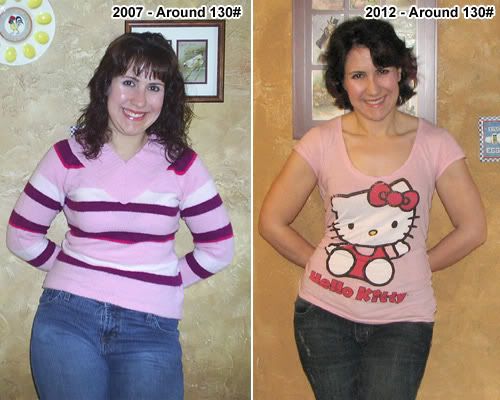
The bottom jeans were the size 8 that I was so happy to wear when I reached 130 back then, and the top are the ones I wear now. They're size 5 in juniors, but I typically wear 2 or 4 in misses. I'm about two inches smaller all over, because I was better at losing body fat.
Like I said, this time around, I lost weight a lot smarter. But I still wasn't "finished" when I reached my goal weight. But I wasn't skinny fat. I had a normal body fat percentage. Probably around 25%. But with good nutrition and weight lifting, I was able to reduce my body fat percentage to the "athletic" range, estimated around 20%.
I'm the same weight in both sets of photos.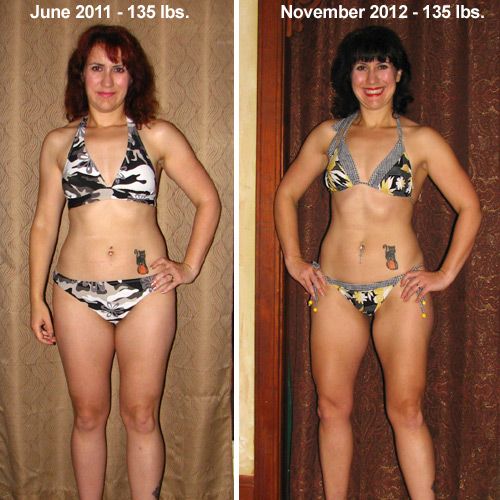

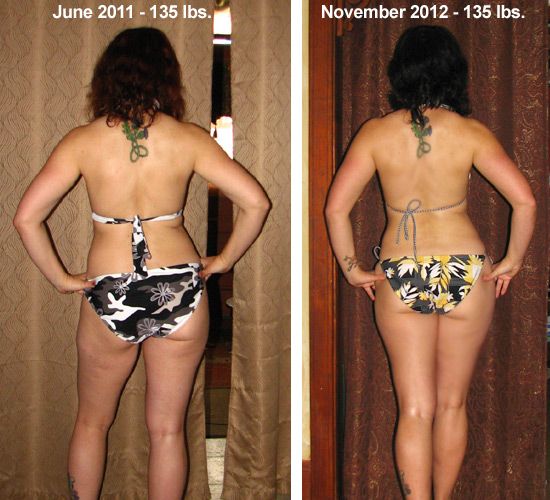
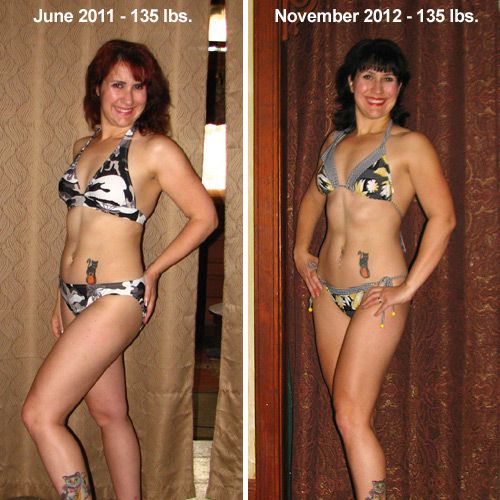 0
0 -
Here some tips to become skinny-fat:
1. Eat a Vegan Diet – If you don’t want to eat any meat, your body will just eat you instead. Unfortunately it’s on a low fat diet in this case.
2. Do lots of cardio – Training your body to be catabolic, breaking down muscle and to store fat is great if you want that “I used to be 300 lbs until I got sick” look.
3. Take lots of thermogenic fat burners – Nothing like turning up the furnace while the windows are open. The room might get warmer, but the bill in the end is never pleasant. Thermogenic maybe be short term fat burners, but in the long run they are more muscle burners and long term fat storers.
4. Go on a low calorie starvation diet – The HCG diet is a great examples. It’s like paying for the experience of a prison camp without making any new undesirable friends.
5. Join weight watchers – Obviously the only point these people haven’t gotten is that if you want to be healthy you should eat a healthy diet and exercise. Is there an app for that?
6. Take a spin class – Did you know spinning classes actually increase lower body fat. Do enough of them and you might slim your waist after you have completely fried your adrenals, but by then you will be sports some major cottage cheese thighs.
7. Never pick up a weight ever – I’m serious, it will make you so huge you will have to walk sideways down the hall to your office. Ok not really, but you know that age old testament, if you don’t use it you lose it. Well it’s pretty accurate when it comes to muscle tissue. If you don’t want to be Skeletor for next Halloween, then you might start moving some iron.
8. Skip meals – Skipping meals is like training for fat storage. The more you go without proper nutrition the more you tell you body to store fat for these long breaks.
9. Eat lots of Gluten – Nothing says lose muscle and store fat like a highly inflammatory food that depletes your body of vital nutrients and damages your digestive tract making it harder for you to get nutrients from the rest of your diet.
Seriously? And what are your credentials? Cycling makes you skinny fat? What a joke. The people I cycle with are anything BUT skinny fat. Please stop bashing what you clearly don't know.
Yeah, my husband was a recreational biker for a long time and he has incredibly firm, muscular, and strong legs. I love his legs!!0 -
What an excellent post! I'm new to this forum so I hope people who read will know what I'm referring to. Thanks for sharing all your photos that demonstrate how important weight bearing exercise is to appearance.0
-
Nnnnnnnooooooooooooooo don't do what I did. I waited until I was 5'7 and 120lbs before I started 'bulking' and as you can see on page 5 in the pictures on the left I had like no muscle so I had to gain 10lbs in hope of acquiring some muscle mass back and so I'm packing on the fat again. Back up to about 20%BF now. Some day, I well have that line down my stomach...it was the vaguest thing ever and I was about 17% BF. Retain the muscle you have now *creepy voice while rattling weights* train now.This is me. This is what skinny fat looks like & I hate it! Trying to get rid of it. I am probably the textbook definition.
You look great.
You aren't skinny fat. Looking at your picture, I'd guess about 25% bf (dangerous to guess)
Skinny fat is 35%bf or higher for someone with a BMI in the "normal" range.
Good luck onyour goals! Please understand that your body is normal and fine - you can go for more fit look, if that is what you want. But let go the hate.Yes, this. Don't mistake "I'm not at my goal yet" for something "there's something wrong with me."
Yes, I've been guessed to b 25% But I'm 5'4 3/4 119lb. That is a bit too high of a BF% for my height & weight I would think. In a few more lbs I'll almost be underweight I hope by that point I can be 20% so I can bulk, but idk if it will happen. Once I posted with my pictures on here & people called me the definition of skinny fat.
I hope by that point I can be 20% so I can bulk, but idk if it will happen. Once I posted with my pictures on here & people called me the definition of skinny fat.
I lift weights on a small deficit now, so I think I"m maintaining MOST of my muscle. I know not all of it. But it's not recommended to bulk at 25% BF.0 -
A lot of people misuse the term skinny fat, to mean someone who is at a healthy weight but does not have muscle definition. This is not the correct definition.
There is such a thing as skinny-fat though, and medically speaking it's not a healthy way to be, as the person is likely to have problems due to being underweight according to their lean body mass, combined with problems due to carrying too much fat. The post I just replied to in this thread has the medical definition of this, i.e. normal weight obesity. "skinny-fat" is a colloquial term for this.
As I mentioned earlier (I think), skinny fat refers to the type of person who looks skinny (male and female) but stores a lot of fat round their mid-section, and particularly worryingly around the organs (which is known to result in various diseases including cancer). Am I right?
well "skinny-fat" is a colloquial term.... normal weight obesity is a medical term. If they look skinny, they can't really be storing that much fat around their midsection.
The problem with colloquial terms is they can mean different things to different people so I'm not really going to argue about the precise definition of a colloquial term. If the term's changed its meaning from "normal weight obesity" to "someone who's thin but not ripped" then I think that's a real shame because a) there's no health risk from being thin but not ripped, in fact it's very healthy, and b) it's become yet another term for body shaming.
what you describe is not "normal weight obesity" as for that someone needs to be underweight according to their lean body mass, but be carrying an obese amount of fat, so the two cancel out and result in a normal BMI.
neandermagnon has great comments and descriptions on here. ^^^0 -
Yes! Good for you.
Nnnnnnnooooooooooooooo don't do what I did. I waited until I was 5'7 and 120lbs before I started 'bulking' and as you can see on page 5 in the pictures on the left I had like no muscle so I had to gain 10lbs in hope of acquiring some muscle mass back and so I'm packing on the fat again. Back up to about 20%BF now. Some day, I well have that line down my stomach...it was the vaguest thing ever and I was about 17% BF. Retain the muscle you have now *creepy voice while rattling weights* train now.This is me. This is what skinny fat looks like & I hate it! Trying to get rid of it. I am probably the textbook definition.
You look great.
You aren't skinny fat. Looking at your picture, I'd guess about 25% bf (dangerous to guess)
Skinny fat is 35%bf or higher for someone with a BMI in the "normal" range.
Good luck onyour goals! Please understand that your body is normal and fine - you can go for more fit look, if that is what you want. But let go the hate.Yes, this. Don't mistake "I'm not at my goal yet" for something "there's something wrong with me."
Yes, I've been guessed to b 25% But I'm 5'4 3/4 119lb. That is a bit too high of a BF% for my height & weight I would think. In a few more lbs I'll almost be underweight I hope by that point I can be 20% so I can bulk, but idk if it will happen. Once I posted with my pictures on here & people called me the definition of skinny fat.
I hope by that point I can be 20% so I can bulk, but idk if it will happen. Once I posted with my pictures on here & people called me the definition of skinny fat.
I lift weights on a small deficit now, so I think I"m maintaining MOST of my muscle. I know not all of it. But it's not recommended to bulk at 25% BF.0 -
This is me. This is what skinny fat looks like & I hate it! Trying to get rid of it. I am probably the textbook definition.
You look great.
You aren't skinny fat. Looking at your picture, I'd guess about 25% bf (dangerous to guess)
Skinny fat is 35%bf or higher for someone with a BMI in the "normal" range.
Good luck onyour goals! Please understand that your body is normal and fine - you can go for more fit look, if that is what you want. But let go the hate.
You would have to have a very slight build to be 35+% BF and still be in "normal" BMI. Normal BMI cutoff for my height is 191. In order to be more than 35% body fat at 191, I'd have to have a LBM of 124 pounds. My LBM is 150ish, and I suspect I'm about average.0 -
This is me. This is what skinny fat looks like & I hate it! Trying to get rid of it. I am probably the textbook definition.
You look great.
You aren't skinny fat. Looking at your picture, I'd guess about 25% bf (dangerous to guess)
Skinny fat is 35%bf or higher for someone with a BMI in the "normal" range.
Good luck onyour goals! Please understand that your body is normal and fine - you can go for more fit look, if that is what you want. But let go the hate.
You would have to have a very slight build to be 35+% BF and still be in "normal" BMI. Normal BMI cutoff for my height is 191. In order to be more than 35% body fat at 191, I'd have to weigh 124 pounds. My LBM is 150ish.
the thing a being skinny fat is having very low LBM0 -
This is me. This is what skinny fat looks like & I hate it! Trying to get rid of it. I am probably the textbook definition.
You look great.
You aren't skinny fat. Looking at your picture, I'd guess about 25% bf (dangerous to guess)
Skinny fat is 35%bf or higher for someone with a BMI in the "normal" range.
Good luck onyour goals! Please understand that your body is normal and fine - you can go for more fit look, if that is what you want. But let go the hate.
You would have to have a very slight build to be 35+% BF and still be in "normal" BMI. Normal BMI cutoff for my height is 191. In order to be more than 35% body fat at 191, I'd have to weigh 124 pounds. My LBM is 150ish.
the thing a being skinny fat is having very low LBM
I understand that, but as a 5'7" male, 124 pounds LBM would require a ridiculously small amount of muscle, The only men I see like that are usually ill, and don't have much fat on them, besides. 0
0 -
This is me. This is what skinny fat looks like & I hate it! Trying to get rid of it. I am probably the textbook definition.
You look great.
You aren't skinny fat. Looking at your picture, I'd guess about 25% bf (dangerous to guess)
Skinny fat is 35%bf or higher for someone with a BMI in the "normal" range.
Good luck onyour goals! Please understand that your body is normal and fine - you can go for more fit look, if that is what you want. But let go the hate.
You would have to have a very slight build to be 35+% BF and still be in "normal" BMI. Normal BMI cutoff for my height is 191. In order to be more than 35% body fat at 191, I'd have to weigh 124 pounds. My LBM is 150ish.
the thing a being skinny fat is having very low LBM
I understand that, but as a 5'7" male, 124 pounds LBM would require a ridiculously small amount of muscle, The only men I see like that are usually ill, and don't have much fat on them, besides.
Thinking about it more, I guess it could happen, with a different body type than my own; perhaps I'm just trying to picture myself looking like that. I wouldn't think it is very common, though.
It would definitely be easier for a woman, too, since they are naturally higher in bodyfat% and less in muscle%. Perhaps 35% is not the cutoff for men.0 -
This is me. This is what skinny fat looks like & I hate it! Trying to get rid of it. I am probably the textbook definition.
You look great.
You aren't skinny fat. Looking at your picture, I'd guess about 25% bf (dangerous to guess)
Skinny fat is 35%bf or higher for someone with a BMI in the "normal" range.
Good luck onyour goals! Please understand that your body is normal and fine - you can go for more fit look, if that is what you want. But let go the hate.
You would have to have a very slight build to be 35+% BF and still be in "normal" BMI. Normal BMI cutoff for my height is 191. In order to be more than 35% body fat at 191, I'd have to weigh 124 pounds. My LBM is 150ish.
the thing a being skinny fat is having very low LBM
I understand that, but as a 5'7" male, 124 pounds LBM would require a ridiculously small amount of muscle, The only men I see like that are usually ill, and don't have much fat on them, besides.
Thinking about it more, I guess it could happen, with a different body type than my own; perhaps I'm just trying to picture myself looking like that. I wouldn't think it is very common, though.
It would definitely be easier for a woman, too, since they are naturally higher in bodyfat% and less in muscle%. Perhaps 35% is not the cutoff for men.
I think it's much more common in women0 -
This is me. This is what skinny fat looks like & I hate it! Trying to get rid of it. I am probably the textbook definition.
You look great.
You aren't skinny fat. Looking at your picture, I'd guess about 25% bf (dangerous to guess)
Skinny fat is 35%bf or higher for someone with a BMI in the "normal" range.
Good luck onyour goals! Please understand that your body is normal and fine - you can go for more fit look, if that is what you want. But let go the hate.
You would have to have a very slight build to be 35+% BF and still be in "normal" BMI. Normal BMI cutoff for my height is 191. In order to be more than 35% body fat at 191, I'd have to weigh 124 pounds. My LBM is 150ish.
the thing a being skinny fat is having very low LBM
I understand that, but as a 5'7" male, 124 pounds LBM would require a ridiculously small amount of muscle, The only men I see like that are usually ill, and don't have much fat on them, besides.
Thinking about it more, I guess it could happen, with a different body type than my own; perhaps I'm just trying to picture myself looking like that. I wouldn't think it is very common, though.
It would definitely be easier for a woman, too, since they are naturally higher in bodyfat% and less in muscle%. Perhaps 35% is not the cutoff for men.
I think it's much more common in women
Yeah, and there are some boxers/wrestlers who are my height who have an LBM nearly that low even with a fair amount of muscle, so it's probably doable.0 -
Damn I used to look good-

5'3, 135 pounds, 32% body fat. Size 6-8
Eta: this is really embarrassing to see... =\. Even my face was fat.....0 -
Hmm. I'd say you are closer to 27% body fat than 32% which would give a LBM of 98.5 lbs vs 92 lbs.Damn I used to look good-
5'3, 135 pounds, 32% body fat. Size 6-8
Eta: this is really embarrassing to see... =\. Even my face was fat.....0 -
Hmm. I'd say you are closer to 27% body fat than 32% which would give a LBM of 98.5 lbs vs 92 lbs.Damn I used to look good-
5'3, 135 pounds, 32% body fat. Size 6-8
Eta: this is really embarrassing to see... =\. Even my face was fat.....
omg...if this is 27% then there is NO WAY I'm 25%. This looks great compared to me 0
0 -
Had a dexa scan :O
I should also add this was August of 2011 and it has taken months upon months to have a more favorable body composition.
Better angle?
Hmm. I'd say you are closer to 27% body fat than 32% which would give a LBM of 98.5 lbs vs 92 lbs.Damn I used to look good-
5'3, 135 pounds, 32% body fat. Size 6-8
Eta: this is really embarrassing to see... =\. Even my face was fat.....0 -
I guess I could be considered skinny fat.0
-
This is me. This is what skinny fat looks like & I hate it! Trying to get rid of it. I am probably the textbook definition.
You look great.
You aren't skinny fat. Looking at your picture, I'd guess about 25% bf (dangerous to guess)
Skinny fat is 35%bf or higher for someone with a BMI in the "normal" range.
Good luck onyour goals! Please understand that your body is normal and fine - you can go for more fit look, if that is what you want. But let go the hate.
You would have to have a very slight build to be 35+% BF and still be in "normal" BMI. Normal BMI cutoff for my height is 191. In order to be more than 35% body fat at 191, I'd have to weigh 124 pounds. My LBM is 150ish.
the thing a being skinny fat is having very low LBM
I understand that, but as a 5'7" male, 124 pounds LBM would require a ridiculously small amount of muscle, The only men I see like that are usually ill, and don't have much fat on them, besides.
Thinking about it more, I guess it could happen, with a different body type than my own; perhaps I'm just trying to picture myself looking like that. I wouldn't think it is very common, though.
It would definitely be easier for a woman, too, since they are naturally higher in bodyfat% and less in muscle%. Perhaps 35% is not the cutoff for men.
That's correct, for men the cut-off is about 25% based on obesity levels of fat for men. Please read on.
But, but! Skinny fat is really the lay term for a disease state. I'd suggest that weight location, along with blood markers really are the true measure of NoWO (aka "skinny fat") . It's a medical concern if you have poor blood work. Everything else is eyeofthebeholder esthetics.0 -
Ladies, I beg you...please quit beating yourself up. You ladies are beautiful NOW, TODAY, IN THOSE PICTURES. If you see something you want to improve onby all means go get it but in the mean time heads up and shake those *kitten* when you walk!0
-
The guy in this youtube video is the picture perfect candidate for skinny fat.
 http://www.youtube.com/watch?v=5v4hFyY6bpY
http://www.youtube.com/watch?v=5v4hFyY6bpY
Looks as if he enjoys it......0
This discussion has been closed.
Categories
- All Categories
- 1.4M Health, Wellness and Goals
- 398.4K Introduce Yourself
- 44.7K Getting Started
- 261K Health and Weight Loss
- 176.4K Food and Nutrition
- 47.7K Recipes
- 233K Fitness and Exercise
- 462 Sleep, Mindfulness and Overall Wellness
- 6.5K Goal: Maintaining Weight
- 8.7K Goal: Gaining Weight and Body Building
- 153.5K Motivation and Support
- 8.4K Challenges
- 1.4K Debate Club
- 96.5K Chit-Chat
- 2.6K Fun and Games
- 4.7K MyFitnessPal Information
- 17 News and Announcements
- 21 MyFitnessPal Academy
- 1.5K Feature Suggestions and Ideas
- 3.2K MyFitnessPal Tech Support Questions











